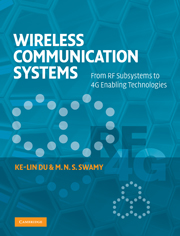Book contents
- Frontmatter
- Contents
- Preface
- Abbreviations
- 1 Introduction
- 2 An overview of wireless communications
- 3 Channel and propagation
- 4 Cellular and multiple-user systems
- 5 Diversity
- 6 Channel estimation and equalization
- 7 Modulation and detection
- 8 Spread spectrum communications
- 9 Orthogonal frequency division multiplexing
- 10 Antennas
- 11 RF and microwave subsystems
- 12 A/D and D/A conversions
- 13 Signals and signal processing
- 14 Fundamentals of information theory
- 15 Channel coding
- 16 Source coding I: speech and audio coding
- 17 Source coding II: image and video coding
- 18 Multiple antennas: smart antenna systems
- 19 Multiple antennas: MIMO systems
- 20 Ultra wideband communications
- 21 Cognitive radios
- 22 Wireless ad hoc and sensor networks
- Appendix A The Q-function
- Appendix B Wirtinger calculus
- Index
1 - Introduction
Published online by Cambridge University Press: 05 June 2012
- Frontmatter
- Contents
- Preface
- Abbreviations
- 1 Introduction
- 2 An overview of wireless communications
- 3 Channel and propagation
- 4 Cellular and multiple-user systems
- 5 Diversity
- 6 Channel estimation and equalization
- 7 Modulation and detection
- 8 Spread spectrum communications
- 9 Orthogonal frequency division multiplexing
- 10 Antennas
- 11 RF and microwave subsystems
- 12 A/D and D/A conversions
- 13 Signals and signal processing
- 14 Fundamentals of information theory
- 15 Channel coding
- 16 Source coding I: speech and audio coding
- 17 Source coding II: image and video coding
- 18 Multiple antennas: smart antenna systems
- 19 Multiple antennas: MIMO systems
- 20 Ultra wideband communications
- 21 Cognitive radios
- 22 Wireless ad hoc and sensor networks
- Appendix A The Q-function
- Appendix B Wirtinger calculus
- Index
Summary
The wireless age
Subsequent to the mathematical theory of electromagnetic waves formulated by James Clerk Maxwell in 1873 and the demonstration of the existence of these waves by Heinrich Hertz in 1887, Guglielmo Marconi made history by using radio waves for transatlantic wireless communications in 1901. In 1906, amplitude modulation (AM) radio was invented by Reginald Fessenden for music broadcasting. In 1913, Edwin H. Armstrong invented the superheterodyne receiver, based on which the first broadcast radio transmission took place at Pittsburgh in 1920. Land-mobile wireless communication was first used in 1921 by the Detroit Police Department. In 1929, Vladimir Zworykin performed the first experiment of TV transmission. In 1933, Edwin H. Armstrong invented frequency modulation (FM). The first public mobile telephone service was introduced in 1946 in five American cities. It was a half-duplex system that used 120 kHz of FM bandwidth. In 1958, the launch of the SCORE (Signal Communication by Orbital Relay Equipment) satellite ushered in a new era of satellite communications. By the mid-1960s, the FM bandwidth was cut to 30 kHz. Automatic channel trunking was introduced in the 1950s and 1960s, with which full-duplex was introduced. The most important breakthrough for modern mobile communications was the concept of cellular mobile systems by AT&T Bell Laboratories in the 1970s.
- Type
- Chapter
- Information
- Wireless Communication SystemsFrom RF Subsystems to 4G Enabling Technologies, pp. 1 - 10Publisher: Cambridge University PressPrint publication year: 2010



